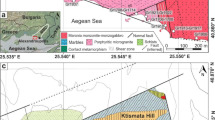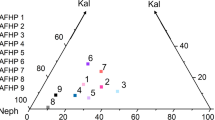Abstract
The possible origin of the Moon’s metallic core at the precipitation of iron–sulfide phases during the partial melting of ultramafic material under various redox conditions was experimentally modeled by partially melting the model system olivine (85 wt %) + ferrobasalt (10 wt %) + metallic phase Fe95S5 (wt %) in a high-temperature centrifuge at 1430–1450°C. The oxygen fugacity fO2 was determined from the composition of the quenched experimental silicate melts (glasses). A decrease in fO2 is proved to be favorable for the segregation of iron–sulfide melt from the silicate matrix. The metallic phase is most effectively segregated in the form of melt droplets, and these droplets are accumulated in the lower portions of the samples under strongly reduced conditions, at fO2 ∼ 4.5–5.5 orders of magnitude lower than the iron–wüstite buffer.
Similar content being viewed by others
References
C. B. Agee, N. M. Mills, D. S. Draper, Workshop on Early Planetary Differentiation. Alkali metals in the Core? Experimental Constraints on Magma Ocean Partitioning of Cs, K, and Na (Astromaterials Institute, University of New Mexico, Albuquerque, 2006).
D. Alfe and M. J. Gillan, “First-principles simulations of liquid Fe-S under Earth’s core conditions,” Phys. Rev. B 58, 8248–8256 (1998).
A. A. Ariskin, A. A. Borisov, and G. S. Barmina, “Modeling of iron–silicate melt equilibrium in basaltic systems,” Geokhimiya, No. 9, 1231–1240 (1992).
Averin V. V. and Yakovlev, O. I. “Thermodynamic modeling of lunar basalt evaporation,” in Proceedings of 11th International Conference of Physicochemical and Petrographic Studies in the Earth’s Science (GEOKhI, Moscow, 2010), pp. 11–14 [in Russian].
V. V. Averin, V. A. Reznichenko, and B. G. Trusov, “Thermodynamic modeling of titanium oxide chllrination,” Tekhnol. Met., No. 8, 45–48 (2008).
N. Bagdassarov, G. Solferino, G. J. Golabek, and M. W. Schmidt, “Centrifuge assisted percolation of Fe–S melts in partially molten peridotite: Time constraints for planetary core formation,” Earth Planet. Sci. Lett. 288, 84–95 (2009).
C. Ballhaus and D. J. Ellis, “Mobility of core melts during Earth’s accretion,” Earth Planet. Sci. Lett. 143, 137–145 (1996).
N. I. Bezmen, “Superliquidus differentiation of fluid-bearing magmatic melts under reducing conditions as a possible mechanism of formation of layered massifs: experimental investigations,” Petrology 9 (4), 345–361 (2001).
D. Bruhn, N. Groebner, and D. L. Kohlstedt, “An interconnected network of core-forming melts produced by shear deformation,” Nature 403, 883–886 (2000).
N. L. Chabot and C. B. Agee, “Core formation in the Earth and Moon: new experimental constraints from V, Cr, and Mn,” Geochim. Cosmochim. Acta 67 (11), 2077–2091 (2003).
N. L. Chabot and M. J. Drake, “Potassium solubility in metal: the effects of composition at 15 kbar and 1900°C on partitioning between iron alloys and silicate melts,” Earth Planet Sci. Lett. 172, 323–335 (1999).
M. J. Drake, H. E. Newsom, and C. J. Capobianco, “V, Cr, and Mn in the Earth, Moon, EPB, and SPB and the origin of the Moon: experimental studies,” Geochim. Cosmochim. Acta 53, 2101–2111 (1989).
W. M. Elsasser, “Early history of the Earth,” in Earth Science and Meteorites, Ed. by J. Geiss and E. Goldberg (Amsterdam, 1963), pp. 1–30.
G. A. Gaetani and T. L. Grove, “Wetting of mantle olivine by sulfide melt: implications for Re/Os–ratios in mantle peridotite and late-stage core formation,” Earth Planet. Sci. Lett. 169, 147–163 (1999).
E. M. Galimov and A. M. Krivtsov, Origin of the Moon. New Concept. Geochemistry and Dynamics (De Gruyter & Co. KG, Berlin–Boston, 2013).
E. M. Galimov, “On the origin of lunar material,” Geochem. Int. 42 (7), 595–609 (2004).
E. M. Galimov, “Problem of the Moon origin,” in Main Directions in Geochemistry. On 100th A.P. Vinogradov Anniversary, Ed. by E.M. Galimov (Nauka, Moscow, 1995), pp. 8–43 [in Russian].
C. K. Gessmann, D. C. Rubie, and C. A. McCammon, “Oxygen fugacity dependence of Ni, Co, Mn, Cr, V, and Si partitioning between liquid metal and magnesiowiistite at 9–18 GPa and 2200°C,” Geochim. Cosmochim. Acta 63 (11–12), 1853–1863 (1999).
G. Hirth and D. L. Kohlstedt, “1. Experimental constraints on the dynamics of the partially molten upper mantle 2. Deformation in the dislocation creep regime,” J. Geophys. Res. 100 (B8), 15441–15449 (1995).
T. Hoink, J. Schmalzl, and U. Hansen “Dynamics of metal-silicate separation in a terrestrial magma ocean,” Geochem., Geophys., Geosyst. 7 (9), (2006).
A. Holzheid, M. D. Schmitz, and T. L. Grove “Textural equilibria of iron sulfide liquids in partly molten silicate aggregates and their relevance to core formation scenarios,” J. Geophys. Res. 105 (B6), 13555–13567 (2000).
J. W. Hustoft and D. L. Kohlstedt, “Metal-silicate segregation in deforming dunitic rocks,” Geochem., Geophys., Geosyst. 7 (2) (2006).
D. Jana and D. Walker, “The influence of sulfur on partitioning of siderophile elements,” Geochim. Cosmochim. Acta. 61 (24), 5255–5277 (1996).
A. A. Kadik and E. B. Lebedev, “Differentiation of partially molten zones of the Moon under conditions of multiphase flow of deep-seated material: a high-temperature centrifuge simulation,” Solar Syst. Res. 33 (5), 392–399 (1999).
A. A. Kadik, E. B. Lebedev, A. M. Dorfman, and N. Sh. Bagdasarov, “Modeling of separation of magmatic melts from crystals using high-temperature centrifuge,” Geokhimiya 1, 43–54 (1989).
A. A. Kadik, Y. A. Litvin, V. V. Koltashev, E. B. Kryukova, V. G. Plotnichenko, T. I. Tsekhonya, and N. N. Kononkova, “Solution behavior of reduced N–H–O volatiles in FeO–Na2O–SiO2–Al2O3 melt equilibrated with molten Fe alloy at high pressure and temperature,” Phys. Earth Planet. Inter. 214, 14–24 (2013).
A. A. Kadik, V. V. Koltashev, E. B. Kryukova, V. G. Plotnichenko, T. I. Tsekhonya, and N. N. Kononkova, “Solubility of nitrogen, carbon, and hydrogen in FeO–Na2O–Al2O3–SiO2 melt and liquid iron alloy: influence of oxygen fugacity,” Geochem. Int. 53 (10), 849–868 (2015).
O. L. Kuskov and V. A. Kronrod, “Geochemical constraints on the model of the composition and thermal conditions of the Moon according to seismic data,” Izv., Phys. Solid Earth 45 (9), 753–768 (2009).
O. L. Kuskov, V. A. Dorofeeva, V. A. Kronrod, and A. B. Makalkin, Systems of Jupiter and Saturn. Formation, Composition and Inner Structure of Large Satellites (Moscow, LKI, 2008) [in Russian].
E. B. Lebedev and A. A. Kadik, “High-temperature centrifuge,” RF Patent no. 2082786, Byull. Isobret. No. 18, (1997)
Lebedev E. B. and Galimov, E. M. “Experimental modeling of the origin of the Moon’s metallic core at partial melting,” Geochem. Int. 50 (8), 639–648 (2012).
E. B. Lebedev and E. M. Galimov, “Physicochemical conditions of experimental modeling of the formation of the Moon’s metallic core at partial melting,” in Problems of Origin and Evolution of Biosphere, Ed. by E. M. Galimov, (KRAS AND, Moscow, 2013), pp. 183–193 [in Russian].
E. B. Lebedev, A. A. Kadik, O. L. Kuskov, A. M. Dorfman, and O. A. Lukanin “The motion of sulfide phases in a partially molten silicate material: application to the problem of the formation of planetary cores,” Solar Syst. Res. 33 (5) 346–355 (1999).
U. Mann, D. J. Frost, and D. C. Rubie, “The effect of Si on dihedral angles between metallic Fe-rich liquids and forsterite and magnesium silicate perovskite,” Geophys. Res. Abstr. 7, 06674 (2005). SRef-ID: 1607-7962/gra/EGU05-A-06674.
N. M. Mills, C. B. Agee, and D. S. Draper, “Metal–silicate partitioning of cesium: implications for core formation,” Geochim. Cosmochim. Acta. 71, 4066–408 (2007).
W. G. Minarik, F. J. Ryerson, and E. B. Watson, “Textural entrapment of core-forming melts,” Science 272. 530–532 (1996).
G. Morard and T. Katsura, “Pressure-temperature cartography of Fe–S–Si immiscible system,” Geochim. Cosmochim. Acta 74 (12), 3659–3667 (2010).
H. S. C. O’Neill and M. I. Pownceby, “Thermodynamic data from redox reactions at high temperatures: I. An experimental and theoretical assessment of the electrochemical method using stabilized zirconia electrolytes, with revised values for the Fe–FeO, Co–CoO, Ni–NiO and Cu–Cu2O oxygen buffers, and new data for the W–WO2 buffer,” Contrib. Mineral. Petrol. 114, 296–314 (1993).
H. S. C. O’Neill and V. J. Wall, “The olivine-orthopyroxene-spinel oxygen geobarometer, the nickel precipitation curve, and the oxygen fugaclty of the Earth’s upper mantle,” J. Petrol. 8 (6), 1169–1191 (1987).
J-P. Poirier, “Light elements in the Earth’s outer core: a critical review,” Phys. Earth Planet. Int. 85, 319–337 (1994).
S. I. Popel’, Surface Phenomena in Melts (Metallurgiya, Moscow, 1994) [in Russian].
V. Raghavan, Phase Diagrams of Ternary Iron Alloys. Part 2: Ternary Systems Containing Iron and Sulphur (Indian Institute of Metals, Calcuta, 1988), pp. 270–278.
W. Rammensee, H. Palme, and H. Wanke, “Experimental investigation of metal-silicate partitioning of some lithophile elements (Ta, Mn, V, Cr),” Lunar Planet. Sci. Conf. 14, 628–629 (1983).
A. E. Ringwood, Origin of the Earth and Moon (Springer, New York, 1979).
J. J. Roberts, J. H. Kinney, J. Siebert, and F. J. Ryerson, “Fe–Ni–S melt permeability in olivine: implication for planetary core formation,” Geophys. Res. Lett. 34, L14306 (2007). doi: doi 10.1029/2007GL030497
D. Rubie, H. Melosh, J. Reid, C. Liebske, and K. Righter, “Mechanisms of metal-silicate equilibration in the terrestrial magma ocean,” Earth Planet. Sci. Lett. 205, 239–255 (2003).
S. K. Runcorn, “The formation of the lunar core,” Geochim. Cosmochim. Acta. 60, 1205–1208 (1996).
T. Rushmer, et al. “Fe-liquid segregationin deforming planetosimals: Coupling core-forming compositions with transport phenomena,” Earth Planet. Sci. Lett. 239, 185–202 (2005).
E. H. Rutter and D. H. K. Neumann, “Experimental deformation of partially molten Westerly granite under fluidabsent conditions, with implications for the extraction of granitic magmas,” J. Geophys. Res. 100 (B8), 15697–15715 (1995).
M. C. Shannon and C. B. Agee, “Percolation of core melts at lower mantle conditions,” Science 280, 1059–1061 (1998).
D. J. Stevenson, “Fluid dynamics of core formation,” in Origin of the Earth, Ed. by H. E. Newsom and H. J. Jones (Oxford Univ. Press, New York, 1990), pp. 231–249.
B. G. Trusov, “Software an Data on the thermodynamic calculations of thermochemical processes,” in 13th International Conference on Physicochemical and Petrophysical Studies in the Earth’s Science, Moscow, Russia, 2012 (Moscow, 2002), pp. 262–265 [in Russian].
B. G. Trusov, “Thermodynamic Terra software,” in Proceedings of 3rd Symposium on Theoretical and Applied Chemistry, Ivanova, Russia, 2002 (Ivanovo, 2002), pp. 217–220 [in Russian].
A. P. Vinogradov, “Differentiation of the lunar and planetary material into shells,” in Cosmochemistry of the Moon and Planets, Ed. by A. P. Vinogradov, (Nauka, Moscow, 1975), pp. 5–28.
N. P. Walte, J. K. Becker, P. O. Bons, D. C. Rubie, and D. J. Frost, “Liquid-distribution and attainment of textural equilibrium in a partially-molten crystalline system with a high-dihedral-angle liquid phase,” Earth Planet. Sci. Lett. 262, 517–532 (2007).
T. Yoshino, M. J. Walter, and T. Katsura “Connectivity of molten Fe alloy in peridotite based on in situ electrical conductivity measurements: implications for core formation in terrestrial planets,” Earth Planet. Sci. Lett. 222, 625–643 (2004).
Author information
Authors and Affiliations
Corresponding author
Additional information
Original Russian Text © E.B. Lebedev, V.V. Averin, O.A. Lukanin, I.A. Roshchina, N.N. Kononkova, E.A. Zevakin, 2016, published in Geokhimiya, 2016, No. 7, pp. 623–632.
Rights and permissions
About this article
Cite this article
Lebedev, E.B., Averin, V.V., Lukanin, O.A. et al. Effect of redox conditions on iron metal phase segregation during experimental high-temperature centrifuge modeling of the origin of the Moon’s core. Geochem. Int. 54, 609–617 (2016). https://doi.org/10.1134/S0016702916070053
Received:
Accepted:
Published:
Issue Date:
DOI: https://doi.org/10.1134/S0016702916070053




